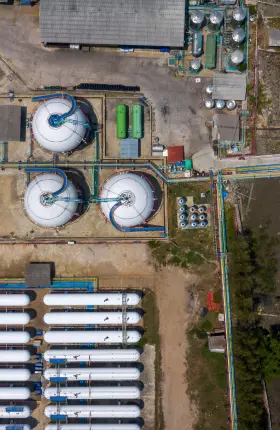This report is the first in a series on the energy transition.
It has been three years since the signing of the Paris Agreement, which committed nearly 200 countries to the goal of limiting global warming to “well below 2 degrees Celsius.” Since then, concerns about climate change have grown in both intensity and scope, expanding beyond the ways in which government policies can minimize warming to the role of companies in generating greenhouse gas (GHG) emissions. With the production and consumption of oil and natural gas products accounting for more than 40% of global GHG emissions, oil and gas companies are confronted with mounting pressure for change.
Companies are increasingly facing public campaigns and legal challenges from environmental activists; demands from investors to disclose climate change-related business risks; calls for greater emissions transparency from government regulators; reduced bank lending for some types of oil and gas projects; and less appetite among young people to work in the industry. At the same time, their ability to craft a coherent response is complicated by uncertainty about future government policies, future demand for hydrocarbons, and the pace at which technological advances and consumer attitudes will evolve.
By applying a strategic framework to their operating models and investment decisions, companies can successfully navigate the challenges and opportunities that lie ahead. Our framework offers a range of responses, depending on how circumstances unfold. (See Exhibit 1.) It does this by addressing five critical questions:
- What overarching strategies, sustainability initiatives, and no-regrets actions should oil and gas companies adopt to respond to the energy transition?
- What is the potential impact of discrete energy transitions on oil and gas companies’ hydrocarbon and petrochemical businesses?
- Should oil and gas companies build new businesses outside of hydrocarbons?
- What changes in companies’ operating models are needed to navigate uncertainty?
- What should oil and gas companies do to safeguard their social license to operate?
1. Developing a Strategic Response to the Energy Transition
The first step for oil and gas companies is to develop an overarching strategy for responding to the global energy transition. This should prioritize no-regrets measures to reduce GHG emissions from companies’ operations while also preparing their businesses for current and future disclosure requirements. Along with short-term actions, companies should also consider a long-term sustainability plan, potentially including emissions targets. At the same time, it is imperative that companies communicate to investors their strategy for creating value regardless of how the energy transition unfolds.
Oil and gas companies contribute a material volume of GHG emissions directly from their own operations—including more than 20% of the global emissions of methane, a highly potent GHG—and they face growing pressure to make curbing their own emissions a priority. Recently, leading players have generally been successful in reducing emissions intensity from the upstream sources they operate (so-called scope 1 and 2 emissions). Between 2014 and 2017, the emissions intensity of upstream operations at six of the seven oil and gas companies we analyzed fell by an average of 10%. (See Exhibit 2.) Our sample comprised Royal Dutch Shell, BP, Total, ExxonMobil, Chevron, Eni, and Equinor. Downstream emissions are more challenging. Over the same period, downstream emissions intensity remained virtually unchanged at most companies.
Companies are also starting to lay the groundwork for future emissions reductions. In 2016−2017, the seven oil and gas companies included in our analysis together launched more than 100 GHG-reducing projects. They included investments in carbon capture (42% of total projects), energy efficiency (25%), gas-flaring abatement (21%), and the reduction of fugitive methane emissions from faulty equipment (12%). These efforts will cut total operating emissions by around 20 million metric tons of carbon dioxide equivalent annually. While that is a start, these initiatives amount to an emissions intensity improvement of less than 1% per company on average. Companies will need to do more.
One relatively easy way for companies to reduce emissions intensity is to cut methane emissions through their natural gas value chains. According to the International Energy Agency, more than half of oil and gas methane emissions can be eliminated at no net cost using existing technologies and other straightforward abatement measures. Put simply, oil companies need to start by cleaning up their own backyard. Recognizing this, members of the Oil and Gas Climate Initiative, a consortium of 13 of the world’s largest global oil and gas companies, have recently set a goal of trimming the methane intensity of their operations by 20% by the end of 2025.
Along with reducing methane emissions, preparing for upcoming policies, particularly those requiring greater climate-related disclosure, is another no-regrets move companies can take. Despite significant and growing pressure on companies to improve transparency, we found the quality of company disclosures on emissions to be lacking in several areas. For example, some companies reported the exact same emissions levels in different segments of their businesses over several years, even though it is highly unlikely that those levels remained unchanged. Oil and gas companies would be better off seizing the initiative and increasing transparency in a compelling and credible way—potentially through certification by third parties–before policymakers take actions that could be more onerous.
As climate policies become more stringent and investors demand more information and action on emissions, companies that fail to demonstrate real urgency about climate change are in danger of being penalized. They will need to shift away from treating GHG emissions as simply a compliance or risk management measure. Companies should begin now to implement new data and reporting systems that can more precisely track emissions and more easily generate high-quality information for disclosure. They should also consider formulating emissions targets.
Pressure is mounting for businesses worldwide to set trackable and enforceable GHG emissions targets. Nearly half of all US Fortune 500 companies have committed to an emissions target. Oil and gas companies face unique challenges in following suit, however. Aggregate emissions from oil companies’ own operations (scope 1 and 2) are driven primarily by production volumes, not just their own operating standards. Meanwhile, scope 3 emissions (known as indirect emissions) are generated mostly by consumption of the fuels that companies produce, so success in curbing them rests in large part on the actions of governments and consumers rather than a company’s internal decisions.
The question of whether and how to set emissions reduction targets will have important implications for oil and gas companies’ operations and long-term portfolio choices. They will need to choose between targeting their total emissions or the emissions intensity of different activities. Equally, they will need to decide whether to target scope 3 emissions as well as scope 1 and 2 emissions. Achieving ambitious direct-emissions targets is within a company’s own control, whereas hitting even moderate scope 3 emissions goals will likely depend on external shifts in energy consumption and would require a high level of industry cooperation. To attack the problem independently could result in a loss of market share—without any change in the sector’s total emissions.
Hitting even moderate scope 3 emissions goals will likely depend on external shifts in energy consumption and would require a high level of industry cooperation.
As they set out plans to improve their sustainability and emissions records, companies shouldn’t lose sight of the need to articulate the continued importance of hydrocarbons. This requires clearly making the case that oil and gas will remain a key component of the energy mix in the near term, delivering substantial economic value to investors and society, even under the most aggressive energy transition scenarios.
2. Preparing for Changes in Your Hydrocarbon Portfolio
Traditionally, oil and gas companies have sought to maximize hydrocarbon resource development and access in the expectation of sustained demand growth. Now, with the potential for more rapid changes in global energy usage, there is an increased likelihood that some production assets could be uncompetitive if demand for hydrocarbons peaks or is weaker than anticipated. Faced with this uncertainty, companies risk overinvesting should these scenarios become a reality or underinvesting should peak-demand concerns prove overstated. At this point, it appears that the greater risk for oil and gas companies is placing too much emphasis on traditional products and markets. According to the International Energy Agency, total oil and gas demand will increase by between 5% and 14% through 2025, depending on the aggressiveness of carbon reduction policies. However, in an analysis of a group of eight international oil and gas companies, BCG found that planned production growth rates are on average about 10 percentage points above that level. (See Exhibit 3.)
In the event of an oil and gas supply glut, there is the dual risk of a weak price environment and an increased likelihood that policymakers will encourage a faster shift away from hydrocarbons. In this scenario, companies with the lowest costs and most flexible portfolios would be in the best position. In particular, oil and gas assets that require relatively little investment and offer short payback periods would be the most desirable. Not only would returns be realized sooner, but these assets would give companies the flexibility to make capital allocation decisions on the basis of hydrocarbon prices and renewables policies.
On a local level, the picture is equally unpredictable. Localized energy transitions, whether regional or within a specific business segment, can be sudden and unexpected and have a more immediate impact on performance. We foresee many scenarios that would have a differentially large impact on specific regions and value chain segments. Three scenarios, in particular, could have significant implications for oil and gas companies:
- Rapid Penetration of Electric Vehicles in Europe. Using BCG’s proprietary models, we simulated the impact on the oil and gas market of scenarios in which EVs accounted for 24% of the European Union vehicle fleet in 2030 and 57% in 2035. The results of this analysis are striking. Sales of gasoline and diesel in Europe could fall by as much as 30% and 28%, respectively, which could cut European refiners’ gross profit margin by as much as 60%. (See Exhibit 4.) This could lead to the shuttering of more than a quarter of Europe’s refining facilities. Two factors could further aggravate the situation for European refiners. In a scenario where EVs make up more than 50% of the European fleet, the impact on demand for hydrocarbon-based fuels could be significantly greater than suggested by the vehicle mix. This is because EVs will likely be used as shared autonomous vehicles, which will clock up far higher annual mileage than vehicles powered by traditional internal combustion engines. In addition, future bans on disposable plastics would impact refiners’ petrochemicals operations.
- Pressure on Fuel Marketing Revenue. Retail fuel marketing has been a stable and growing source of oil and gas company profits. While improvements in internal combustion engine efficiency have curbed the growth in fuel sales, particularly in Europe, the major oil companies have compensated by increasing nonfuel revenue (from fast-food and convenience outlet sales) at gasoline stations. These ancillary operations typically account for more than a third (sometimes as much as 50%) of international oil company retail margins. As EVs and on-demand autonomous vehicles become more prevalent, both fuel and convenience retail sales will be increasingly at risk. In a scenario where electric becomes 40% to 50% of the EU vehicle fuel mix, our modeling shows that the average return on capital employed (ROCE) for a highway service station could easily drop from 12% today to 1%. The performance of urban sites would decline even more, with average ROCE dropping from 7% today to −2%.
- Demand for Natural Gas in the US Stagnates. While shale gas production is growing significantly in the US, headwinds are developing that may slow market demand . If renewables adoption and battery storage cost reductions accelerate, and if local climate change targets become more aggressive (most likely in states such as California or regions such as the Northeast), natural gas demand could fall 7 trillion cubic feet below base case expectations by 2040, a drop of 18%. This would result in a much weaker natural gas price environment and would also dramatically change the marginal investment curve for US gas production.
The oil and gas sector must prepare for the twists and turns of such energy transitions and their impact on companies’ hydrocarbon portfolios. Companies will need to assess the effect of renewables and other disruptive forces on hydrocarbon demand from both a global and a local perspective. By conducting a portfolio stress test, they can explore a range of potential scenarios, assess their future competitiveness and market position on the basis of the merit order of their assets, and determine their risk exposure and ability to navigate unanticipated developments. This stress test should be used to create a roadmap for their portfolio in the short and long term, with the competitiveness of current assets and future investments likely to be the name of the game.
Oil and gas companies must be careful not to neglect specific risks and exposures in regional markets, but they should also be aware of opportunities. For instance, the shift from coal to natural gas in China could provide a potential upside should this trend accelerate in response to environmental concerns. On the whole, paying close attention to local conditions can inform more nuanced strategies for geographic hedging and managing more general global exposure.
Paying close attention to local conditions can inform more nuanced strategies for geographic hedging and managing more general global exposure.
3. Expanding into New Energy
One response to the energy transition has been for oil and gas companies to increase the share of nonhydrocarbon energy assets in their portfolios. Given their size and core competencies, large oil and gas companies need to consider which opportunities could have a material impact on their bottom line and what capabilities they can tap to succeed in new areas.
Oil and gas players are starting small. In 2018, renewable energy accounted for less than 0.1% of the total energy provided by seven of the world’s largest oil and gas companies, according to our analysis of company reports. Major international oil companies have announced plans to invest an average of 2.5%—and in some cases as much as 6%—of their total capital expenditure on renewable projects over the next five years. But even with the increased investment, renewables would still represent a fraction of their portfolios. The reality is that most of these companies’ actual capital expenditure in alternative and renewable energies is at the bottom end of their stated ambitions.
We see potential new business opportunities for oil and gas producers in the following nontraditional areas:
- The power value chain, including the production and retail sale of large-scale and decentralized renewable energy
- Advanced mobility and new fuels, such as biofuels, hydrogen for fuel cells, and EV charging stations
- Energy efficiency equipment, software, and business models, such as the development of service companies that use digital tools to measure and improve the energy intensity of plant operations inside and outside the industry
- Carbon capture, utilization, and storage (CCUS) technologies that capture carbon dioxide from power plants or industrial sites for use or permanent disposal
- The circular economy, such as waste-to-energy production, plastics recycling, and carbon sinks
Like any new product lines, these opportunities come with their own set of challenges. For example, the technical, regulatory, and market risks in the renewables business are different from those in hydrocarbon production, and they are still evolving. And since many nonhydrocarbon energy technologies remain at the research and development phase, including hydrogen fuel and CCUS equipment, substantial upfront investment may be necessary.
Moreover, an oil and gas company planning a significant expansion into renewable energy would have to rethink its approach to scale, anticipated returns, and portfolio structure. Oil and gas projects demand a huge capital investment, with returns as high as 40%. But because project returns are uncertain and can be affected by factors such as fluctuating oil prices, it’s important to spread bets across a large, multiregion portfolio. By contrast, the investment needs of a renewables project are typically lower; but so, too, are the returns, although they are more stable.
Some oil and gas companies are considering investing in nonhydrocarbon technologies as a way to reduce their scope 3 emissions footprint and meet emissions targets, but this would require a significant shift in portfolio investment. For instance, a typical large oil and gas producer that wants to achieve a 10% across-the-board improvement in emissions intensity would have to add 150 gigawatts of wind and solar generation capacity. This is roughly equivalent to the total installed wind and solar capacity in the US.
It is important that oil and gas companies find attractive and material opportunities where they can identify a competitive advantage. This underlines the need for every oil and gas company to craft a clearly defined plan, led from the top, that articulates its overall intentions and positioning, along with the actions it will take to navigate the energy transition. We find that many companies can sharpen the coherence of both their internal strategy and their external narrative.
4. Creating a More Flexible Operating Model
Responding to the energy transition poses new operational challenges for oil and gas companies, including how they engage with key stakeholders, what they report, how they organize their businesses, and how they market core products.
Implementing emissions reporting procedures can be a daunting task, and not just because of oil and gas companies’ inherent complexity and scale. There is little agreement in the industry about how carbon footprints should be measured or reported. This could undermine confidence in the industry’s efforts to curb emissions. Credible reports, matched against organizational commitments, are critical to assuring the public, activists, and policymakers.
According to the nonprofit Carbon Disclosure Project, which runs a voluntary environmental-impact disclosure system, self-reported data from the oil and gas industry has revealed variations in emissions factors among individual companies of 2% per unit of natural gas and 6% per unit of liquid fuel. (See Exhibit 5.) Given the high volume of fuel sold across all companies, these variations can have a substantial effect on the accuracy of absolute emissions calculations. Similarly, methane emissions accounting can vary substantially depending on the inputs and methodology used. For example, recent research found discrepancies of more than 60% in total emissions throughout the US natural gas value chain, depending on calculation methods.
The uncertainty over the pace and scope of change is also complicating planning and decision-making procedures. In particular, traditional modeling approaches that use deterministic methods and take a relatively linear view of the future can fall short if there are rapid market and policy shifts. While these methods are valuable when making practical decisions about expected rates of return from a project or an investment, they have been shown to miss or understate the potential impact from rapid market shifts caused by energy transitions.
To meet the challenge of managing future energy transitions, companies will need to adopt more flexible and comprehensive operating models that combine several components:
- Data reporting systems that assure management and external stakeholders of the feasibility of a company’s stated ambitions and its performance in achieving those ambitions
- Processes that facilitate decision making in the face of greater uncertainty by incorporating scenario-based, dynamic analysis to forecast, manage risks, and enable the development of creative strategic choices
- Capabilities to manage new, less traditional businesses and to bring greater digital skills and a more customer-oriented approach to existing ones
- Management approaches for integrating new technologies and ventures into a company’s broader portfolio while enabling these businesses to develop and grow
5. Safeguarding the Social License to Operate
Many oil and gas companies are highly skilled at building localized support for projects or specific issues. But they have not sufficiently developed compelling narratives about their role in the transition to new global energy systems. As Dominic Emery, vice president of strategic planning at BP, puts it: “We tend to use techno-economic arguments in the face of emotional ones … and then are surprised when we do not connect.”
This shortcoming has hurt public perception of the industry. Oil and gas companies, particularly in Europe and North America, are often viewed as poor environmental stewards. Studies regularly show that, outside of Asia and emerging markets, there is a general lack of trust in the industry. These negative public perceptions in turn increase the pressure on governments, investors, and lenders to take a harder line with oil and gas companies.
Neither individual companies nor the industry as a whole has prioritized communication and external engagement in a rapidly evolving landscape. A more robust response will be critical to proactively shaping engagement with key stakeholders as the industry grapples with the energy transition. What’s more, oil and gas companies, while sharing a common interest, have generally failed to create consistent industrywide messages. They will need to address this if they are to improve their standing with stakeholders.
The industry can start by emphasizing its positive contributions to society, including expanded energy access, economic development, and improved reliability and security of supply. It can also better explain the role that natural gas could play in certain regions to reduce GHG emissions and local air pollution. It is important that these messages are structured so they are transparent, aligned with local interests, and not self-serving. They are likely to fall flat unless companies articulate what they are doing to improve sustainability and respond to energy transitions. Clearly stating company emissions objectives and being more transparent about exposure to climate change risks are critical for building greater trust in the industry.
Companies can also do more to build inclusive coalitions of stakeholders to set common standards that provide a more credible response to challenges. Oil and gas companies often do this successfully at the local level. In the US, for example, shale industry groups made up of industry, government, and nonprofit organizations established to set standards are starting to provide transparent, albeit still imperfect, operating data. Yet such a response is lacking at the regional and global level.
Addressing the Challenges Ahead
The global energy transition poses unique challenges for oil and gas companies, requiring them to adapt their strategies and core operations in new ways. Hydrocarbon consumption will not collapse overnight. However, mounting public concern about environmental impacts will put more and more pressure on oil and gas companies. Industry executives need to adopt a holistic approach to addressing the difficult questions arising from stakeholder concerns about climate change and the uncertain effects of energy transitions on their core businesses.
Industry executives need to adopt a holistic approach to addressing the difficult questions arising from stakeholder concerns about climate change.
There are several no-regrets actions companies can take in this evolving landscape. First, they should prioritize emissions reduction in their core operations. Second, oil and gas companies must upgrade their operating models and improve their governance and reporting measures to deal with the complexities of emissions accounting. Credible reporting procedures are critical to gaining the confidence of the public and of governments and enabling companies to demonstrate progress. Equally, oil and gas companies will need to improve their scenario-based planning, stress testing future strategies based on more extreme scenarios rather than relying on the base case.
Beyond these actions, oil and gas companies face important overarching strategic questions:
- How will they shape their existing hydrocarbon portfolios, given rapidly evolving local or regional dynamics, to ensure these core businesses are competitive? Companies that tackle this challenge directly are likely to gain a significant edge over competitors.
- Is it time to expand into new business areas, with different financial profiles and capability requirements? Before taking this step, oil and gas companies will need to determine if they can develop the “right to win” in these markets.
Finally, oil and gas companies must address challenges to their social license to operate head-on. It is essential that they establish and maintain credibility with the public via proactive, empathetic, and constructive engagement with their stakeholders, pursue actions based on global standards and policies, and promote clear and transparent environmental performance data.
The stakes for the oil and gas industry are higher than ever. Companies that respond effectively to the energy transition will create a competitive advantage and generate sustainable value over the long term. The heat is on.
















